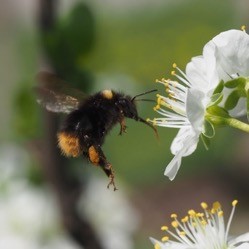Early bumblebee visiting
plum flowers
Urban gardening is
increasingly popular and appreciated for its contribution to food security,
biodiversity, environmental education and general wellbeing. Although many of
the food crops popular in urban gardens depend on pollination by insects,
studies on pollination services in urban environments are still scarce. In
particular, little is known on the specific role of wild bee communities as
crop pollinators in cities, while urban beekeeping is on the rise.
We analysed wild bee visitation rates on apple, plum, cherry, pear, blackberry, raspberry, and strawberry in a Bavarian city with a very high honeybee density. During 137,5 hours of observation time, we observed 52 wild bee species on the studied crop plants. During more than 50 hours of observation time on fruit trees in flower, we found that wild bees provided 41% of the total bee visits, honeybees the remaining 59%. Honeybee hive density had a significantly negative effect on wild bee abundance. Bumblebees appeared more tolerant to poor weather conditions than all other bee groups.
Our findings suggest that species-rich wild bee communities in urban areas are important for pollination success in common fruit crops, especially under unstable spring weather conditions. Bee-friendly management of urban spaces should be prioritised to support wild bee communities as well as the increasing number of honeybees in cities to make urban insect communities and fruit crop production more resilient to changing climates.
Appropriate measures to improve resource availability and connectivity should consider the specific needs of diverse wild bee communities regarding nesting habitat, nesting materials and flowering plant species composition and provenience. In order to reduce competition with endangered wild bees, the bee keepers should consider the available floral resources in their surroundings from early spring to late autumn and adapt their number of hives accordingly.
Read the scientific publication in JPE.


No comments:
Post a Comment